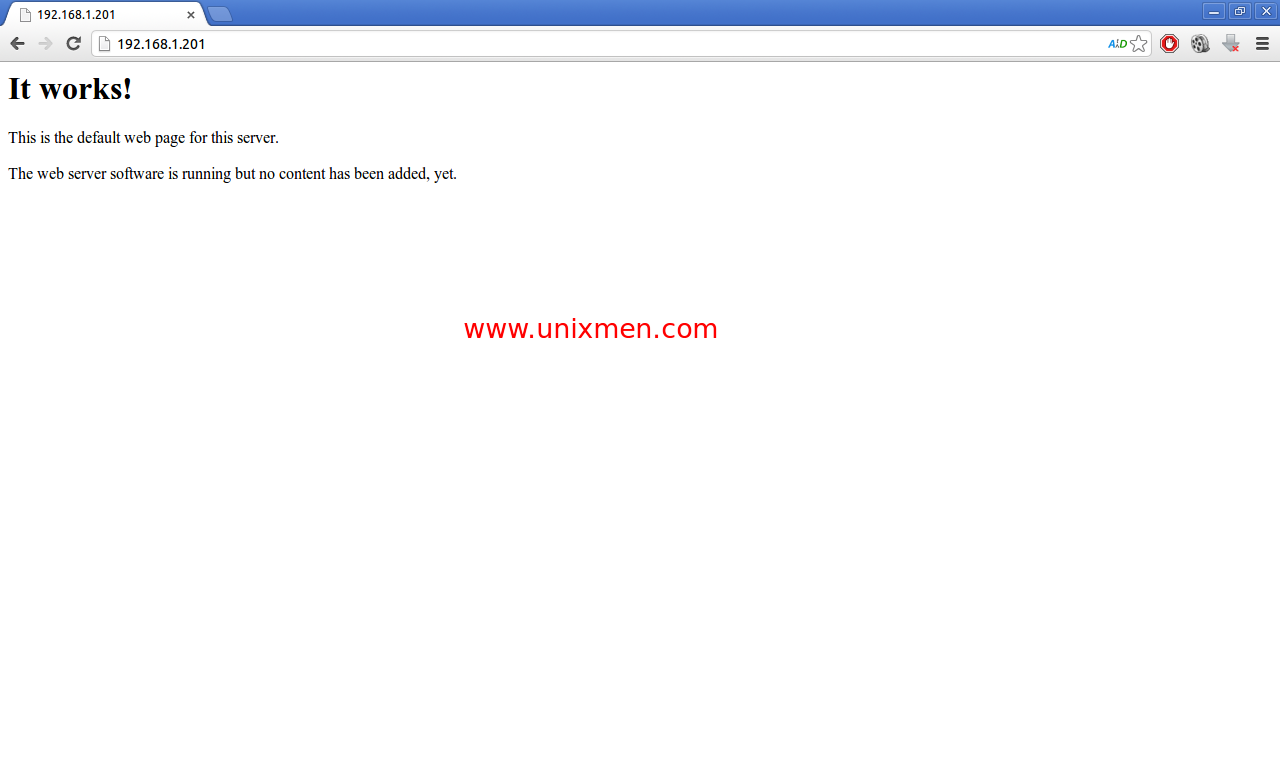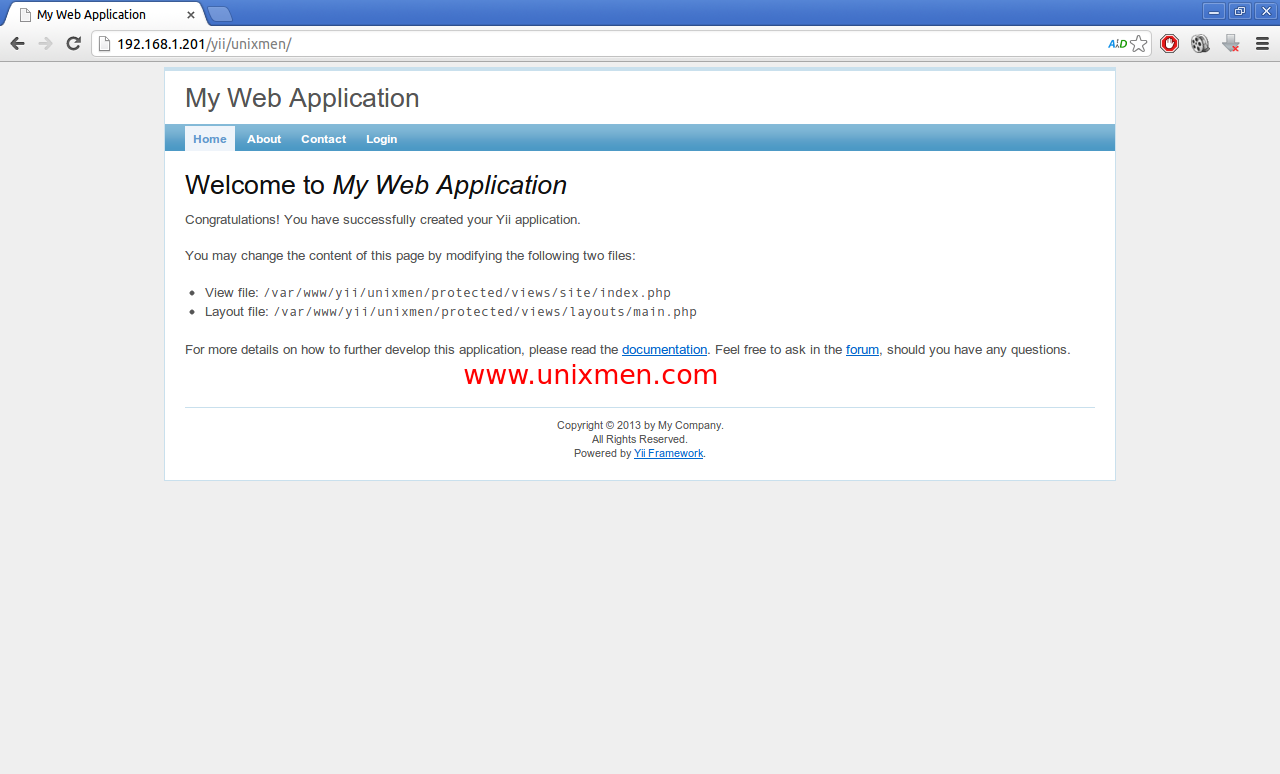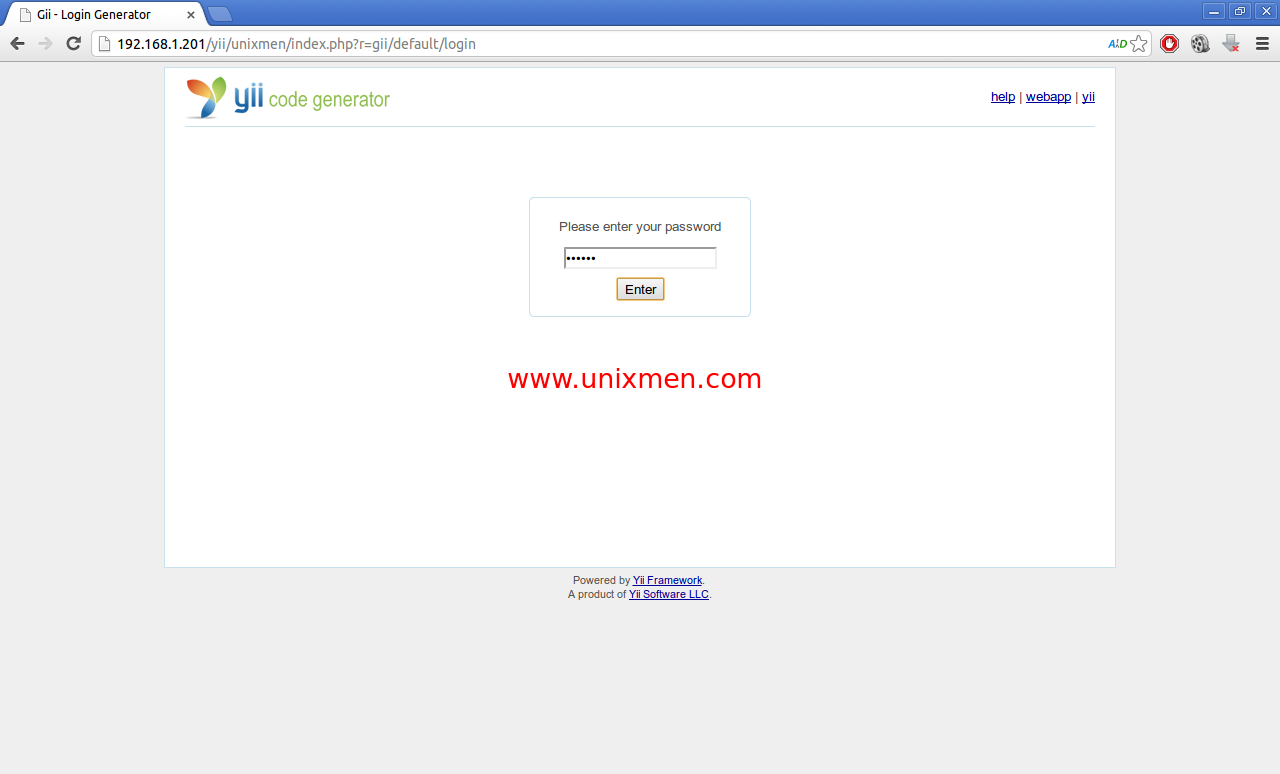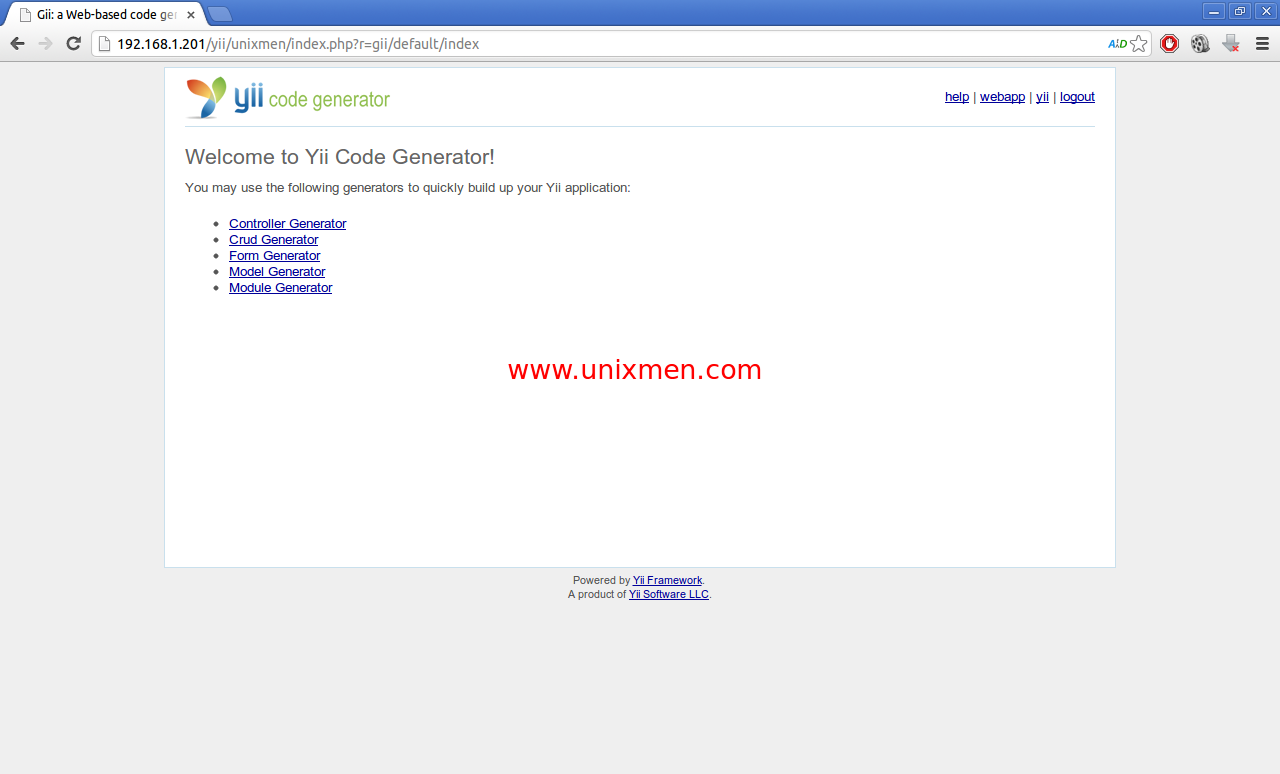Yii is an open source, fast, secure and as well as high performance PHP framework used for developing large-scale web applications. In this walk-through let us learn how to install Yii on Ubuntu/Debian and its derivatives.
Install Yii On Ubuntu
I tested this under Ubuntu 12.10 Server, although it will work on Ubuntu/Debian new editions. Well, let us get started!
If you haven’t installed Apache and PHP, install them with following command:
sk@server1:~$ sudo apt-get install apache2 php5 libapache2-mod-php5
If things goes well, you should see the Apache home page as shown below. Navigate to http://ip-address/ from your browser to see Apache home page.
Create MySQL database for Yii
Let us create a database ‘yiidb‘ and a database user called ‘yiiuser‘ with password ‘ubuntu‘. Change these values as per your scenario:
sk@server1:~$ mysql -u root -p Enter password: Welcome to the MySQL monitor. Commands end with ; or \g. Your MySQL connection id is 45 Server version: 5.5.31-0ubuntu0.12.10.1 (Ubuntu) Copyright (c) 2000, 2013, Oracle and/or its affiliates. All rights reserved. Oracle is a registered trademark of Oracle Corporation and/or its affiliates. Other names may be trademarks of their respective owners. Type 'help;' or '\h' for help. Type '\c' to clear the current input statement. mysql> create database yiidb; Query OK, 1 row affected (0.02 sec) mysql> GRANT ALL PRIVILEGES ON yiidb.* TO 'yiiuser' IDENTIFIED BY 'ubuntu'; Query OK, 0 rows affected (0.00 sec) mysql> flush privileges; Query OK, 0 rows affected (0.01 sec) mysql> exit Bye
Now grab the latest version from the official download page or simply download it via terminal as shown below:
sk@server1:~$ wget http://yii.googlecode.com/files/yii-1.1.13.e9e4a0.tar.gz
Extract the downloaded file:
sk@server1:~$ tar zxvf yii-1.1.13.e9e4a0.tar.gz
It will be extracted as a folder called “yii-1.1.13.e9e4a0” in your current directory. Change to this directory and move all contents to /var/www/ folder as shown below:
sk@server1:~$ sudo mv yii-1.1.13.e9e4a0/ /var/www/yii
Now create a directory under /var/www/yii/ directory for a sample project. Let’s call it as unixmen. So here I create a folder called unixmen under /var/www/yii/ directory:
sk@server1:~$ sudo mkdir /var/www/yii/unixmen
Assign the full permission for unixmen directory:
sk@server1:~$ sudo chmod -R 777 /var/www/yii/unixmen/
Enter the following command to begin installation:
sk@server1:~$ php /var/www/yii/framework/yiic.php webapp /var/www/yii/unixmen/ Create a Web application under '/var/www/yii/unixmen'? (yes|no) [no]:yes mkdir /var/www/yii/unixmen/css generate css/screen.css generate css/bg.gif generate css/form.css generate css/ie.css generate css/print.css generate css/main.css generate index-test.php generate index.php mkdir /var/www/yii/unixmen/images mkdir /var/www/yii/unixmen/themes mkdir /var/www/yii/unixmen/themes/classic mkdir /var/www/yii/unixmen/themes/classic/views mkdir /var/www/yii/unixmen/themes/classic/views/system mkdir /var/www/yii/unixmen/themes/classic/views/layouts generate themes/classic/views/.htaccess mkdir /var/www/yii/unixmen/themes/classic/views/site mkdir /var/www/yii/unixmen/assets mkdir /var/www/yii/unixmen/protected mkdir /var/www/yii/unixmen/protected/data generate protected/data/testdrive.db generate protected/data/schema.sqlite.sql generate protected/data/schema.mysql.sql mkdir /var/www/yii/unixmen/protected/controllers generate protected/controllers/SiteController.php mkdir /var/www/yii/unixmen/protected/tests generate protected/tests/phpunit.xml mkdir /var/www/yii/unixmen/protected/tests/fixtures mkdir /var/www/yii/unixmen/protected/tests/unit generate protected/tests/WebTestCase.php mkdir /var/www/yii/unixmen/protected/tests/functional generate protected/tests/functional/SiteTest.php generate protected/tests/bootstrap.php mkdir /var/www/yii/unixmen/protected/tests/report mkdir /var/www/yii/unixmen/protected/runtime mkdir /var/www/yii/unixmen/protected/messages mkdir /var/www/yii/unixmen/protected/config generate protected/config/main.php generate protected/config/console.php generate protected/config/test.php mkdir /var/www/yii/unixmen/protected/extensions mkdir /var/www/yii/unixmen/protected/views mkdir /var/www/yii/unixmen/protected/views/layouts generate protected/views/layouts/main.php generate protected/views/layouts/column1.php generate protected/views/layouts/column2.php mkdir /var/www/yii/unixmen/protected/views/site generate protected/views/site/login.php generate protected/views/site/index.php generate protected/views/site/contact.php mkdir /var/www/yii/unixmen/protected/views/site/pages generate protected/views/site/pages/about.php generate protected/views/site/error.php mkdir /var/www/yii/unixmen/protected/components generate protected/components/UserIdentity.php generate protected/components/Controller.php mkdir /var/www/yii/unixmen/protected/commands mkdir /var/www/yii/unixmen/protected/commands/shell generate protected/yiic.php mkdir /var/www/yii/unixmen/protected/migrations mkdir /var/www/yii/unixmen/protected/models generate protected/models/ContactForm.php generate protected/models/LoginForm.php generate protected/.htaccess generate protected/yiic generate protected/yiic.bat Your application has been created successfully under /var/www/yii/unixmen.
Now test the new project by navigating to http://ip-address/yii/unixmen from your browser.
Yii Framework has been installed now.
Enable Yii code generation tool GiiModule
Starting from version 1.1.2, Yii is equipped with a web-based code generation tool called GiiModule. GiiModule is a module which provides web-based code generation capabilities.
To enable GiiModule, edit the main.php file found under /var/www/yii/unixmen/protected/config/ directory:
sk@server1:~$ sudo nano var/www/yii/unixmen/protected/config/main.php
Scroll down to modules section. It will look like as shown below:
[...] 'modules'=>array( // uncomment the following to enable the Gii tool /* 'gii'=>array( 'class'=>'system.gii.GiiModule', 'password'=>'Enter Your Password Here', // If removed, Gii defaults to localhost only. Edit car$ 'ipFilters'=>array('127.0.0.1','::1'), ), */ ), [...]
Remove “/*” and “*/” lines to uncomment and enter your ip address series in the ipFilters line. And specify the password to login to code generator. I use ubuntu as my password. So after modification, it will look like as follows:
[...] 'modules'=>array( // uncomment the following to enable the Gii tool 'gii'=>array( 'class'=>'system.gii.GiiModule', 'password'=>'ubuntu', // If removed, Gii defaults to localhost only. Edit car$ 'ipFilters'=>array('127.0.0.1','192.168.1.*'), ), ), [...]
Scroll down further, you will find db section looks like as follows:
[...] /* 'db'=>array( 'connectionString' => 'mysql:host=localhost;dbname=test$ 'emulatePrepare' => true, 'username' => 'root', 'password' => '', 'charset' => 'utf8', ), */ [...]
Remove “/*” and “*/” lines to uncomment and enter your database name, database username and password. So after the modification, it will look like as follows:
[...] // uncomment the following to use a MySQL database 'db'=>array( 'connectionString' => 'mysql:host=localhost;dbname=yiidb', 'emulatePrepare' => true, 'username' => 'root', 'password' => 'ubuntu', 'charset' => 'utf8', ), [...]
Save and exit the file. Now try to access the GiiModule by navigating to http://ip-address/yii/unixmen/index.php?r=gii from your browser.
Enter the password to login to yii code generator. In my case its ubuntu.
Now you will able to login to GiiModule code generator.
That;s it. Start using Yii. I highly recommend to refer the Yii Wiki page for beginners.









